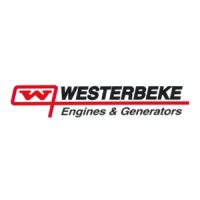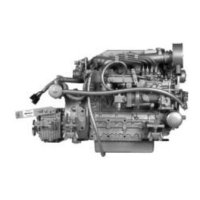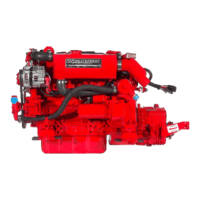SAFETY
INSTRUCTIONS
INmODUCTION
Read
this
safety manual
carefuUy.
Most accidents
are
coused
by
failure to follow fwuIomentol rules
and
precau-
tions.
Know
when dangerous
conditWns
exist and take the
necessary
precautions
to
protect yourself, your
personne~
and
your
11IIlChilUlry.
The following
safety
instructions
are
in compliance with
the American Boat
and
Yacht
Council (ABYC)
standards.
PREVENT
ElECTRIC
SHOCK
A
WARNING:
Do
nut
touch
AC
electrical
CDlIII/JctiOIlS
while
/JIIgine
is
mnning,
or
when
connected
to
shore
power.
Lethal
voltage
Is
PT/JSIJnt
at
thestJ
connections!
•
Do
not
operate
this
machinery
without electrical
enclosmes
and
covers
in
place.
• Shut off electrical power before accessing electrical
equipment.
•
Use
insulated
mats
whenever
working
on
electrical
equipment.
• Make
sure
your
clothing and skin are
dry,
not
damp
(particularly shoes)
when
handling electrical equipment.
•
Remove
wristwatch
and
all
jewelry
when
working
on
electrical equipment
•
Do
not
connect utility shore power
to
vessel's
AC
circuits, except through a ship-to-shore double throw
transfer
switch.
Damage
to
vessel's
AC
generator
may
result if
this
procedure
is
not
followed.
• Electrical shock results
from
handling a charged capaci-
tor.
Discharge
capacitor
by
shorting
terminals
together.
PREVENT
BURNS
-
HOT
ENGINE
A
WARNING:
00
not
touch
hot
engine
parts
or
BXhaust
system
components.
A
mnning
engine
gets
vBfYhot!
•
Always
check
the
engine coolant
level
at
the
coolant
recovery
tank.
A
WARNING:
Steam
can
cause
Injuty
or
death!
• In case of
an
engine overheat,
allow
the
engine
to
cool
before
touching
the
engine or checking the coolant.
PREVENT
BURNS
-
FIRE
A
WARNING:
Fire
can
cause
Injuty
or
death!
• Prevent
flash
fires.
Do
not smoke or permit
flames
or
sparks
to
occur
near
the
carburetor,
fuel
line,
filter,
fuel
pump,
or
other potential
sources
of
spilled
fuel
or
fuel
vapors.
Use
a suitable container
to
catch
all
fuel
when
removing
the
fuel
line,
carburetor,
or
fuel
filters.
•
Do
not
operate
with
a Coast
Guard
Approved
flame
arrester
removed.
Backfire
can
cause severe injury or
death.
•
Do
not
operate
with
the
air cleaner/silencer
removed.
Backfire
can
cause severe injury or
death.
•
Do
not
smoke
or
permit
flames
or
sparks
to
occur
near
the
fuel
system.
Keep
the compartment and
the
engine/generator
clean
and
free
of
debris
to
minimize
the
chances
of
fire.
Wipe
up
all
spilled
fuel
and engine
oil.
•
Be
aware
- diesel
fuel
will
burn.
PREVENT
BURNS
-
EXPLOSION
A
WARNING:
ExplosiollS
from
fuel
rapol$
can
cause
Injuty
or
death!
• Follow re-fueling safety instructions.
Keep
the vessel's
hatches
closed
when
fueling.
Open
and
ventilate
cabin
after
fueling.
Check
below for fumes/vapor before
run-
ning
the
blower.
Run
the blower for
four
minutes before
starting your
engine.
•
All
fuel
vapors
are
highly
explosive.
Use
extreme
care
when
handling
and
storing
fuels.
Store
fuel
in
a well·ven-
tilated
area
away
from
spark-producing equipment
and
out of
the
reach of children.
•
Do
not
fill
the
fuel
tank(s)
while
the
engine
is
running.
•
Shut
off
the
fuel
service
valve
at
the
engine
when
servicing
the
fuel
system.
Take
care
in
catching
any
fuel
that
might
spill.
DO
NOT
allow
any
smoking,
open
flames,
or
other
sources
of
fire
near
the
fuel
system
or
engine
when
servic-
ing.
Ensure
proper
ventilation
exists
when
servicing
the
fuel
system.
•
Do
not
alter
or
modify
the
fuel
system.
•
Be
sure
all
fuel
supplies
have
a positive shutoff
valve.
•
Be
certain
fuel
line
fittings
are
adequately
tightened
and
free
ofleaks.
•
Make
sure a
fire
extinguisher
is
installed
nearby
and
is
properly
maintained.
Be
familiar
with
its
proper
use.
Extinguishers
rated
ABC
by
the
NFPA
are
appropriate
for
all
applications encountered
in
this
environment.
Engines & Generators

